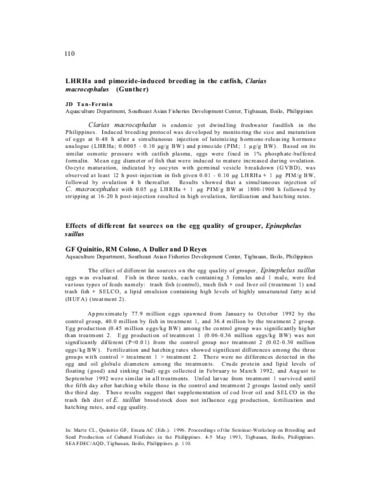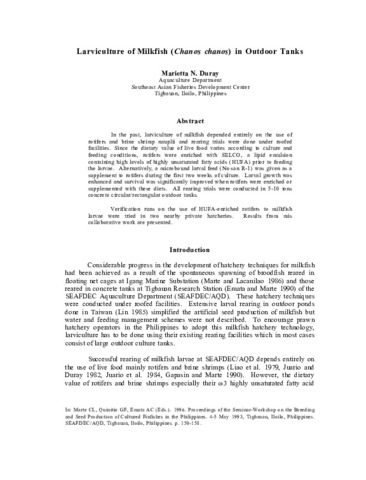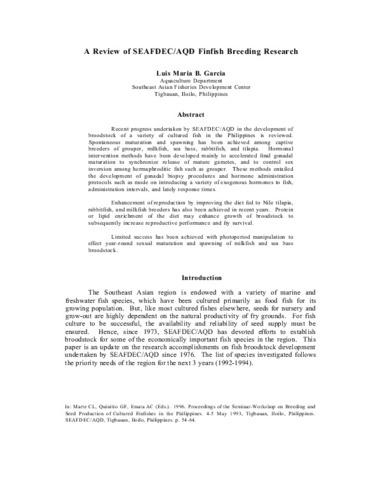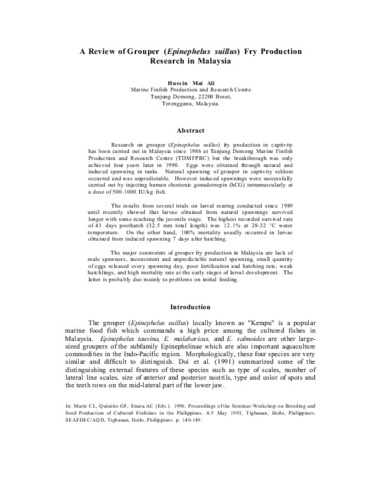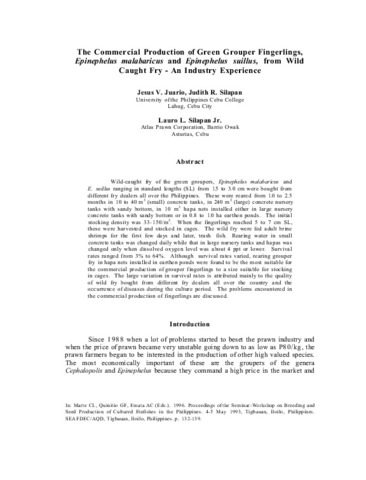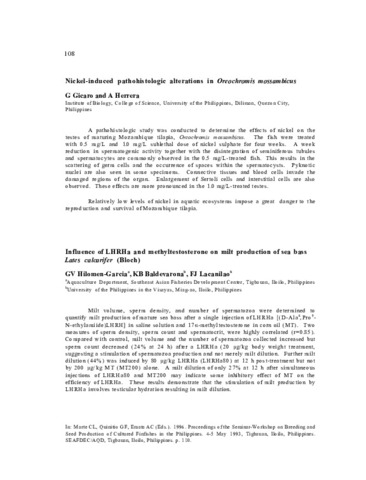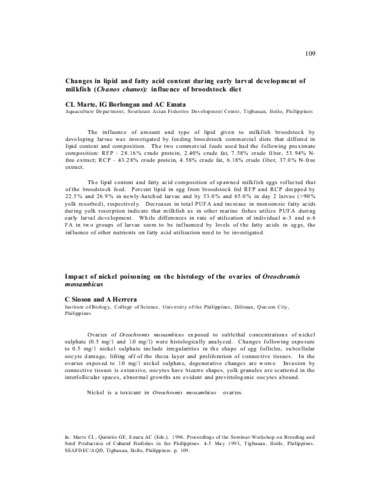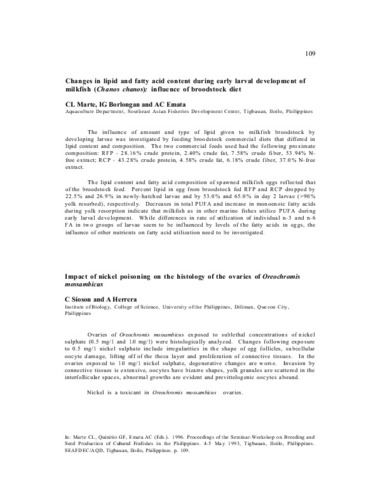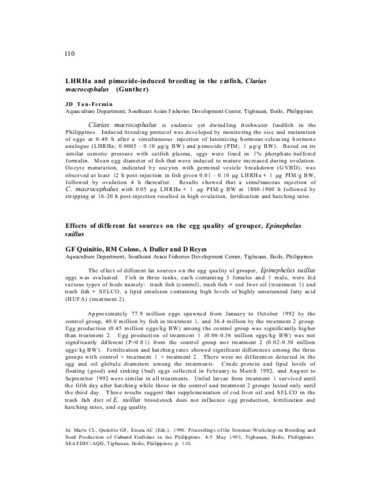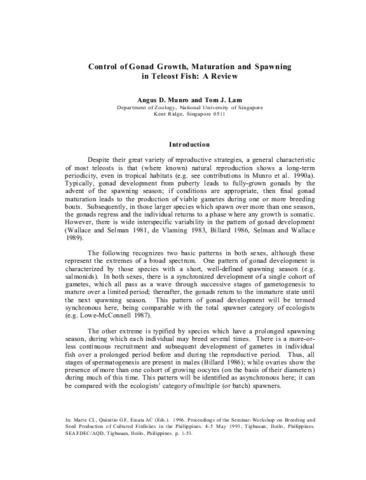Breeding and Seed Production of Cultured Finfishes in the Philippines: Recent submissions
Now showing items 21-31 of 31
-
Effects of different fat sources on the egg quality of grouper, Epinephelus suillus
(Aquaculture Department, Southeast Asian Fisheries Development Center, 1996)The effect of different fat sources on the egg quality of grouper, Epinephelus suillus eggs was evaluated. Fish in three tanks, each containing 3 females and 1 male, were fed various types of feeds namely: trash fish ... -
Larviculture of milkfish (Chanos chanos) in outdoor tanks
(Aquaculture Department, Southeast Asian Fisheries Development Center, 1996)In the past, larviculture of milkfish depended entirely on the use of rotifers and brine shrimp nauplii and rearing trials were done under roofed facilities. Since the dietary value of live food varies according to culture ... -
A review of SEAFDEC/AQD finfish breeding research
(Aquaculture Department, Southeast Asian Fisheries Development Center, 1996)Recent progress undertaken by SEAFDEC/AQD in the development of broodstock of a variety of cultured fish in the Philippines is reviewed. Spontaneous maturation and spawning has been achieved among captive breeders of ... -
A review of grouper (Epinephelus suillus) fry production research in Malaysia
(Aquaculture Department, Southeast Asian Fisheries Development Center, 1996)Research on grouper (Epinephelus suillus) fry production in captivity has been carried out in Malaysia since 1986 at Tanjung Demong Marine Finfish Production and Research Centre (TDMFPRC) but the breakthrough was only ... -
The commercial production of green grouper fingerlings, Epinephelus suillus, from wild caught fry - an industry experience
(Aquaculture Department, Southeast Asian Fisheries Development Center, 1996)Wild-caught fry of the green groupers, Epinephelus malabaricus and E. suillus ranging in standard lengths (SL) from 1.5 to 3.0 cm were bought from different fry dealers all over the Philippines. These were reared from 1.0 ... -
Influence of LHRHa and methyltestosterone on milt production of sea bass Lates calcarifer (Bloch)
(Aquaculture Department, Southeast Asian Fisheries Development Center, 1996)Milt volume, sperm density, and number of spermatozoa were determined to quantify milt production of mature sea bass after a single injection of LHRHa [(D-Ala6,Pro9-N-ethylamiide)LHRH] in saline solution and 17α-methyltestosterone ... -
Nickel-induced pathohistologic alterations in Oreochromis mossambicus
(Aquaculture Department, Southeast Asian Fisheries Development Center, 1996)A pathohistologic study was conducted to determine the effects of nickel on the testes of maturing Mozambique tilapia, Oreochromis mossambicus. The fish were treated with 0.5 mg/L and 1.0 mg/L sublethal dose of nickel ... -
Impact of nickel poisoning on the histology of the ovaries of Oreochromis mossambicus
(Aquaculture Department, Southeast Asian Fisheries Development Center, 1996)Ovaries of Oreochromis mossambicus exposed to sublethal concentrations of nickel sulphate (0.5 mg/1 and 1.0 mg/1) were histologically analyzed. Changes following exposure to 0.5 mg/1 nickel sulphate include irregularities ... -
Changes in lipid and fatty acid content during early larval development of milkfish (Chanos chanos): influence of broodstock diet
(Aquaculture Department, Southeast Asian Fisheries Development Center, 1996)The influence of amount and type of lipid given to milkfish broodstock by developing larvae was investigated by feeding broodstock commercial diets that differed in lipid content and composition. The two commercial feeds ... -
LHRHa and pimozide-induced breeding in the catfish, Clarias macrocephalus (Gunther)
(Aquaculture Department, Southeast Asian Fisheries Development Center, 1996)Clarias macrocephalus is endemic yet dwindling freshwater foodfish in the Philippines. Induced breeding protocol was developed by monitoring the size and maturation of eggs at 0-48 h after a simultaneous injection of ... -
Control of gonad growth, maturation and spawning in teleost fish: A review
(Aquaculture Department, Southeast Asian Fisheries Development Center, 1996)Despite their great variety of reproductive strategies, a general characteristic of most teleosts is that (where known) natural reproduction shows a long-term periodicity, even in tropical habitats (e.g. see contributions ...

